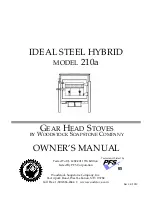
FLOOR PROTECTION REQUIREMENTS
Your Woodstock Soapstone stove must be set on an approved hearth or floor protection.
The hearth protects your floor from two hazards:
• Heat Transfer: Heat radiation from the bottom, front, and sides of the woodstove
• Ember Protection: Sparks and hot coals that may fall out during ash removal and reloading of firewood
DO NOT INSTALL YOUR WOODSTOCK SOAPSTONE STOVE ON A COMBUSTIBLE SUR-
FACE (WOOD, CARPET, LAMINATE, OR VINYL, FOR EXAMPLE).
Even if you have a stone or tile overlay on wood, it is still considered combustible since the surface materials will not
provide adequate heat transfer protection.
Your stove
MUST
sit on one of the following:
•
A hearth pad of solid masonry (brick or tile on concrete and mortared in place)
•
A prefabricated hearth pad listed to UL1618 approved standards. These pads are made to be placed on an existing
floor. Woodstock Soapstone Company has a good selection of these pre-made pads.
•
A custom designed pad constructed of approved non-combustible materials which will protect the floor from sparks,
hot coals, and ashes; and prevents heat from being transferred onto the floor beneath.
I
F
YOU
CHOOSE
TO
BUILD
YOUR
OWN
HEARTH
PAD
1)
Start with a plywood base or subfloor.
Over this apply:
2)
a layer of insulating board with an R-Value of at least 0.41. Depending on the mate-
rial you choose, the insulating board can be as little as 1/2” thick. For additional
help with material specifications, contact Woodstock Soapstone Company at 1-800-
866-4344 or [email protected].
Over this apply:
3)
1/4” or greater of a decorative, non-combustible material such as tile, slate, stone,
or brick. Use mortar or grout to set the material in place, then grout the seams.
Specifications for floor protectors
may be listed in terms of R-value,
K-value, or C-value. To convert K
or C value to R-value use the fol-
lowing formulas.
K to R: R=1/K x T (Thickness of
the alternate material)
C to R: R=1/C
Once alternate materials have been
converted to R-values, the values
of multiple layers can be added to
determine the combined protection.
If the overall R-value meets or
exceeds the specified .41 then the
materials are acceptable.
DO NOT USE:
Old-fashioned stove boards that were commonly sold in hardware stores as they
DO NOT
have ade-
quate protection and
ARE NOT
approved for primary floor protection under your stove.
Hearth Rugs also
ARE NOT
meant to be used as primary hearth protection. These are made to be used in addition to
an approved hearth, and are an auxiliary decorative protection. They are not a substitute for an approved hearth pad.
You can build your own hearth pad to fit
your decor. The hearth pad must meet a
minimum R value of .41
trim
board
1/4” slate or tile
3/4” plywood
or subfloor
non-combustible
insulation board
6
R-values of common hearth materials:
Ceramic Tile
1/4”
0.020
Granite
1/4”
0.020
Slate
1/4”
0.025
Cement Mortar
1/2”
0.025
Cementboard
1/4”-1/2”
0.20-0.39
Common Brick
2.25”
0.450
Common Brick
4.00”
0.800
Mineral/Ceramic Fiber Board
1/2”
1.10-1.470
Please Note:
Always check with the manufacturer of the hearth material used
to verify the R or K value.
K Values cannot be added. Convert to R value before adding multiple layers.











































